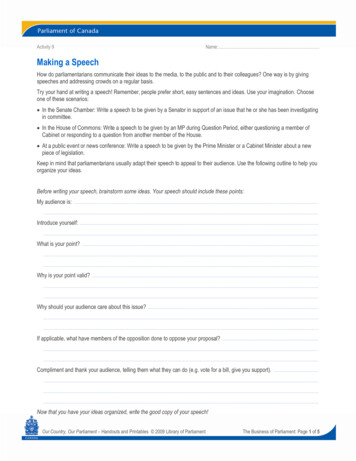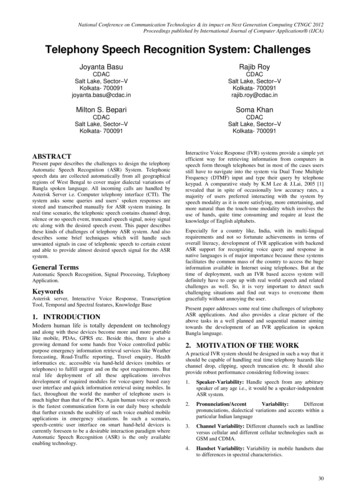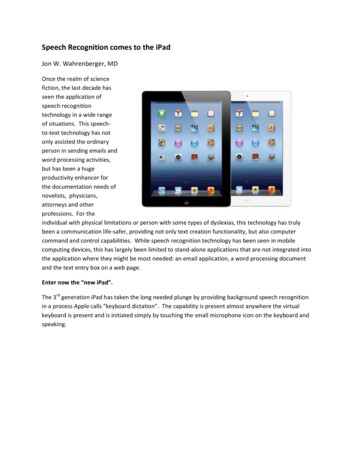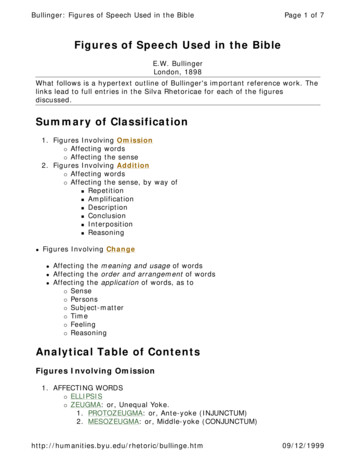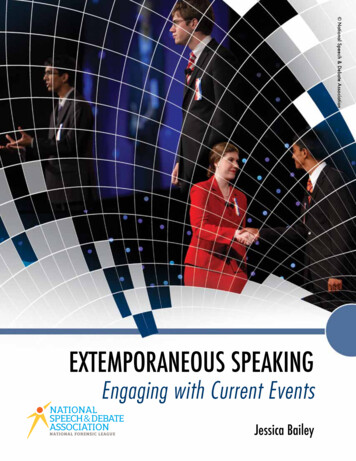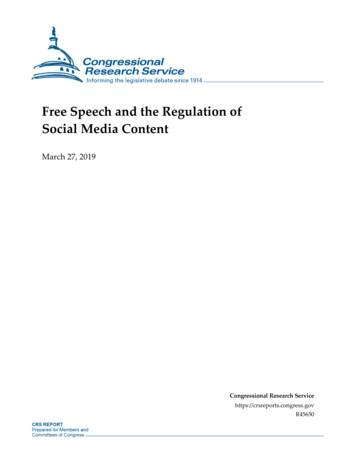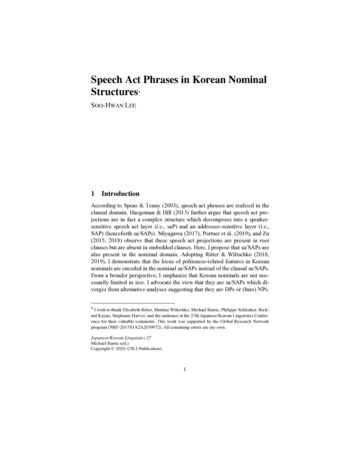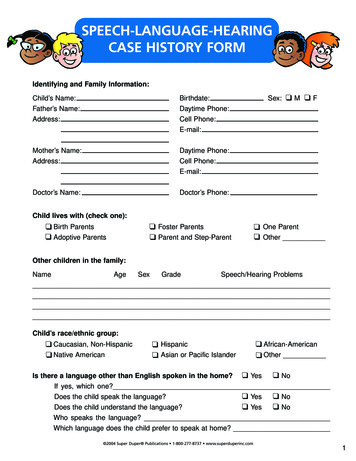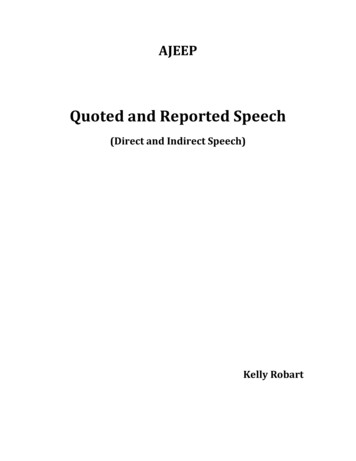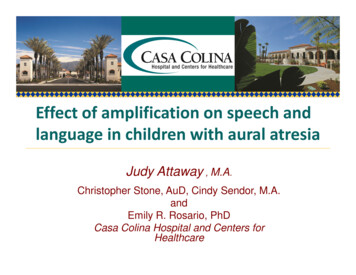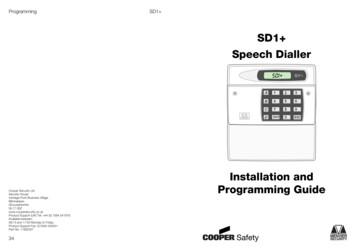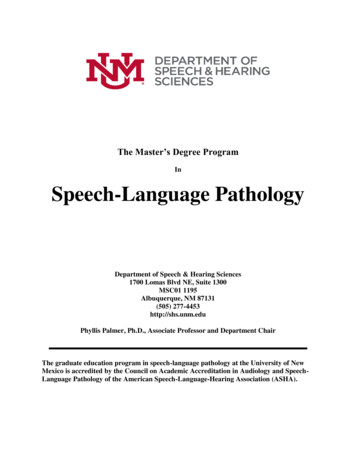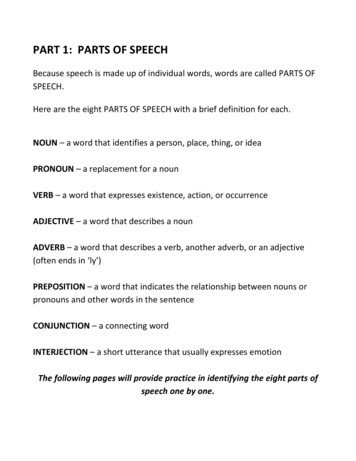
Transcription
PART 1: PARTS OF SPEECHBecause speech is made up of individual words, words are called PARTS OFSPEECH.Here are the eight PARTS OF SPEECH with a brief definition for each.NOUN – a word that identifies a person, place, thing, or ideaPRONOUN – a replacement for a nounVERB – a word that expresses existence, action, or occurrenceADJECTIVE – a word that describes a nounADVERB – a word that describes a verb, another adverb, or an adjective(often ends in ‘ly’)PREPOSITION – a word that indicates the relationship between nouns orpronouns and other words in the sentenceCONJUNCTION – a connecting wordINTERJECTION – a short utterance that usually expresses emotionThe following pages will provide practice in identifying the eight parts ofspeech one by one.
Nouns are words that identify a person [teenager], place [Toronto], thing[table], or idea [hope].Nouns can be singular [table] or plural [tables].Nouns can be common [table] or proper [Elizabeth]. Proper nouns alwaysstart with a capital.In the following example sentences, the nouns are shaded red.The cat jumped on the table.An elephant is bigger than a car.Elizabeth is full of hope.Colour the nouns red in the following sentences. The answers follow on thenext page.1. The dog jumped on the sofa.2. A monkey is smarter than a cow.3. Jonathan doesn’t have much imagination.4. The boys and girls danced in the sunshine.5. The teacher went to Australia for a visit.6. Mrs. Smith gave us bananas and apples.7. The school had a fence, a sidewalk, and a playground.8. Yesterday, my mother got a letter from my grandmother.9. At our cottage in Muskoka, the lake is very close to the porch.10. On Tuesday, all the girls go to the gym.11. Which computer does Brendan use for work?2
ANSWERS1. The dog jumped on the sofa.2. A monkey is smarter than a cow.3. Jonathan doesn’t have much imagination.4. The boys and girls danced in the sunshine.5. The teacher went to Australia for a visit.6. Mrs. Smith gave us bananas and apples.7. The school had a fence, a sidewalk, and a playground.8. Yesterday, my mother got a letter from my grandmother.9. At our cottage in Muskoka, the lake is very close to the porch.10. On Tuesday, all the girls go to the gym.11. Which computer does Brendan use for work?Pronouns are words that replace nouns. Instead of “Scott”, one coulduse the word “he” or “him”. Instead of “the cats”, one could use the word“they” or “them”. Instead of “the book”, one could use the word “it” or“this”. In the following sentences, the pronouns are shaded pink.We put them to sleep ourselves.If you will take that, then I will take this.The cats don’t like us, and we don’t like them.3
Colour the pronouns pink in the following sentences. The answers follow.1.2.3.4.5.6.7.8.He was afraid that he had lost it.Did you tell them about it?They thought she was on the train.On Monday, he hurt himself playing hockey.This is the high road and that is the low road.The teacher gave it to me.I would like to do it myself.She went with us to look for the missing dog.ANSWERS1. He was afraid that he had lost it.2. Did you tell them about it?3. They thought she was on the train.4. On Monday, he hurt himself playing hockey.5. This is the high road and that is the low road.6. The teacher gave it to me.7. I would like to do it myself.8. She went with us to look for the missing dog.4
Verbs are words that express action, existence, or occurrence. Most partsof speech are usually a single word, but verbs are often made up of severalwords (because they include expressions of time). The additional words inmulti-word verbs are called helper or auxiliary verbs, and they aresometimes separated from the main verb (especially by the word “not”).This verb tense chart might be helpful.In the following example sentences, the verbs are shaded yellow.Jeremy ran down the road.We are never alone.The lawyer had been hoping for a miracle.Colour the verbs yellow in the following sentences. The answers follow onthe next page.1. The girls opened the door.2. She is a very pretty baby.3. The raccoons have been washing their food for ages.4. The kangaroo can jump very high.5. All the king’s men can not put Humpty Dumpty together again.6. The cowboy had been chewing on a stalk of alfalfa.7. If you gave them this candy, the little boys would become very happy.8. Are you sure you broke the plate?9. Later on today, Peter and Janet will be going to a movie.10. Before I lose my temper, I always count to three.5
ANSWERS1. The girls opened the door.2. She is a very pretty baby.3. The raccoons have been washing their food for ages.4. The kangaroo can jump very high.5. All the king’s men can not put Humpty Dumpty together again.6. The cowboy had been chewing on a stalk of alfalfa.7. If you gave them this candy, the little boys would become very happy.8. Are you sure you broke the plate?9. Later on today, Peter and Janet will be going to a movie.10. Before I lose my temper, I always count to three.Contractions and NegativesSometimes verbs are contracted with their pronoun subject: for example, “Iam” might be written “I’m” and “you are” might be written “you’re”.Sometimes, the adverb “not” forms part of the contraction. In the followingexample sentences, the contraction is written out in full and the verb isshaded yellow.They’re (THEY ARE) going to lose their shirts.We’ll (WE WILL) never be sick at sea.Don’t (DO NOT) forget about the timer on the oven.6
Expand the contractions (in the margins) and colour all of the verbs yellowin the following sentences. The answers follow.1. She can’t really follow in her mother’s footsteps.2. Unfortunately, they didn’t understand the directions on the cake mixbox.3. Aidan wasn’t listening to the teacher at that particular moment.4. His father told him that he wouldn’t be at the homecoming party.5. It’s really terrific that you like each other.6. Katherine reminded me that you’re not like other people.7. He’ll be moving to Ireland next spring.8. While I’m looking for sweaters, you should look at the jewellery.9. Let’s go to the baseball game while we’re in Pasadena.ANSWERS1. She can’t (CAN NOT) really follow in her mother’s footsteps.2. Unfortunately, they didn’t (DID NOT) understand the directions on thecake mix box.3. Aidan wasn’t (WAS NOT) listening to the teacher at that particularmoment.4. His father told him that he wouldn’t (WOULD NOT) be at thehomecoming party.5. It’s (IT IS) really terrific that you like each other.6. Katherine reminded me that you’re (YOU ARE) not like other people.7. He’ll (HE WILL) be moving to Ireland next spring.8. While I’m (I AM) looking for sweaters, you should look at the jewellery.9. Let’s (LET US) go to the baseball game while we’re (WE ARE) inPasadena.7
Adjectives are words that describe nouns. Three adjectives – “a”, “an”and “the” - are in a special category of their own called “articles”. There isalso a special group of pronouns – the ones showing possession – that countas adjectives: for example, “my” and “theirs”. In the following examplesentences, the adjectives are shaded grey.The beautiful lady gave me a wonderful smile.He looked into her big brown eyes.I hope I will win an enormous apple because I’m really hungry.Colour the adjectives grey in the following sentences. The answers follow onthe next page.1. The cute little bunny was hopping around in our garden.2. Jennifer’s first doll lost her head in a terrible accident.3. Our American friends are coming for a short visit.4. Jason’s old dog always comes along on his trips to the big orchard.5. Alison was embarrassed when her elderly aunt shouted loudly.6. My bruises are turning yellow and purple now.7. The huge orangutan and the tiny kitten made a curious pair.8. When you are crossing a busy street, you must be really careful.9. We have wonderful news!10. Adjectives are useful because they tell you more about nouns.8
ANSWERS1. The cute little bunny was hopping around in our garden.2. Jennifer’s first doll lost her head in a terrible accident.3. Our American friends are coming for a short visit.4. Jason’s old dog always comes along on his trips to the big orchard.5. Alison was embarrassed when her elderly aunt shouted loudly.6. My bruises are turning yellow and purple now.7. The huge orangutan and the tiny kitten made a curious pair.8. When you are crossing a busy street, you must be really careful.9. We have wonderful news!10. Adjectives are useful because they tell you more about nouns.Adverbs are words that describe verbs, adverbs, and adjectives. Theyanswer the questions how, when, where, and how much, and often end inthe letters ‘ly’. In the following example sentences, the adverbs are shadedgreen.We slowly walked to our house. (The adverb is describing the verb“walked”.)Monday was an extremely cold day. (The adverb is describing the adjective“cold”.)The children laughed very happily. (The adverb is describing the adverb“happily”.)Colour the adverbs green in the following sentences. The answers follow.9
1.2.3.4.5.6.7.8.9.Bob shouted loudly and ran quickly across the driveway.The very sad dog headed home.The girls moved too slowly to suit their teacher.The young children were eagerly waiting for Christmas.We have a really nice cat.The boys ate their dinner so hungrily that mother brought out seconds.Alicia accidentally broke her aunt’s best china plate.The show dog is beautifully groomed.Yesterday it rained, today it is sunny, and tomorrow it is supposed tobe cloudy.10. The adverb is one of the most totally confusing and absolutelyannoying parts of speech.ANSWERS1. Bob shouted loudly and ran quickly across the driveway.2. The very sad dog headed home.3. The girls moved too slowly to suit their teacher.4. The young children were eagerly waiting for Christmas.5. We have a really nice cat.6. The boys ate their dinner so hungrily that mother brought out seconds.7. Alicia accidentally broke her aunt’s best china plate.8. The show dog is beautifully groomed.9. Yesterday it rained, today it is sunny, and tomorrow it is supposed tobe cloudy.10. The adverb is one of the most totally confusing and absolutelyannoying parts of speech.10
Prepositions are words that indicate the relationship between nouns orpronouns and other words. They introduce prepositional phrases thatusually indicate location, direction or association. In the following examplesentences, the prepositions are shaded brown.Tom lived near the pond.Jeremy headed towards the north side of the town.My father thinks you look like Marilyn Monroe.Colour the prepositions brown in the following sentences. The answersfollow on the next page.1. My house is at the end of this street.2. The car drove through the woods and into the valley.3. Do you have a lot of money for me?4. Tie a yellow ribbon around the old oak tree.5. The three girls are no longer friends with each other.6. The little cat sat patiently beside her food dish.7. Margaret lives in an old house.8. From the start, he was addicted to music.9. She slid down the hill and over the fence.10. The hat fell off the table and onto the floor.11
ANSWERS1. My house is at the end of this street.2. The car drove through the woods and into the valley.3. Do you have a lot of money for me?4. Tie a yellow ribbon around the old oak tree.5. The three girls are no longer friends with each other.6. The little cat sat patiently beside her food dish.7. Margaret lives in an old house.8. From the start, he was addicted to music.9. She slid down the hill and over the fence.10. The hat fell off the table and onto the floor.Conjunctions are words that connect words, phrases, or clauses. Thereare two kinds of conjunctions – co-ordinate conjunctions (like “and”, “so”,and “but”) and subordinate conjunctions (like “which”, “when”, and“because”). In order to understand conjunctions properly, students need toknow what phrases, principal clauses and subordinate clauses are. More willbe explained about these topics later on, but for now it’s enough to knowthat principal clauses can stand alone, while subordinate clauses cannotstand alone. There’s a cute video on prepositional phrases here.can join words. BobSally are happy.can join phrases. Jeremy raced over the hilldown the road.can join principal clauses. The pigs squealed,the cows lowed.join subordinate clauses to principal clauses. Theyatethey talked.12
Colour the co-ordinate conjunctions that join words,the co-ordinate conjunctions that join phrases, colour the co-ordinate conjunctionsthat join principal clauses, and outline the subordinate conjunctionsin.1.2.3.4.5.6.7.8.9.Byron likes to think in terms of dollars and cents.She lives near the bridge but far from the pond.We were out of groceries, so we went to the supermarket.My father really likes the painting that hangs on your wall.When my sisters were infants, they cried all night long.Over the hills and through the valleys we went.After the babies had had their nap, they needed to be fed.The carpenters like to build schools but not cinemas.Prepositions introduce phrases but conjunctions join them.ANSWERS1. Byron likes to think in terms of dollarscents.2. She lives near the bridge but far from the pond.3. We were out of groceries, we went to the supermarket.4. My father really likes the paintinghangs on your wall.5.my sisters were infants, they cried all night long.6. Over the hills and through the valleys we went.7.the babies had had their nap, they needed to be fed.8. The carpenters like to build schools but not cinemas.9. Prepositions introduce phrases,conjunctions join them.13
Interjections are short utterances that usually express emotion. In thefollowing example sentence, the interjection is shaded aqua.Ouch! That hurt.Colour the interjections purple in the following sentences. The answersfollow.1. My gosh, that’s a huge pumpkin!2. I can’t go to school today, alas.3. Ladies and gentlemen, ahem, dinner is served.ANSWERS1. My gosh, that’s a huge pumpkin!2. I can’t go to school today, alas.3. Ladies a
annoying parts of speech. ANSWERS 1. Bob shouted loudly and ran quickly across the driveway. 2. The very sad dog headed home. 3. The girls moved too slowly to suit their teacher. 4. The young children were eagerly waiting for Christmas. 5. We have a really nice cat. 6. The boys ate their dinner so hungrily that mother brought out seconds. 7 .
